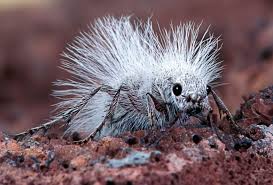In a dry, open field, a hungry lizard spots a brightly-coloured, hairy insect scurrying across the sandy soil. Thinking it has found a meal, the lizard sprints to catch the insect. But once it has the insect in its mouth, it finds it is too hard to chew.
The lizard then moves the insect around to find a softer chewing angle but gets nowhere. Meanwhile the insect starts to squeak and finally stings the luckless lizard in its mouth. Alarmed, the lizard spits it out.
The insect, still squeaking, gets away unscathed. The lizard is left with nothing but a sore mouth and a foul taste.
This sturdy insect is a female velvet ant. These females have an arsenal of defences unmatched by their male partners, or any other insect. The question is, what terrifying predator forced the females to evolve so many defences? And if they are in such dire threat from predators, why are they brightly coloured.
Let’s get the confusing bit out of the way first. Velvet ants are not really ants: they are wasps. They got their name because the females look like large ants, albeit ants clothed in dense velvety hairs of various hues: they can be yellow, orange, red, white or black.
However, the females are both grounded and conspicuous. Their bright colours may seem like a dead giveaway, but they are actually a signal warning predators to stay away – just like the bright colours of a wasp warn predators that it can sting.
Source :BBC
N.H.KHider

